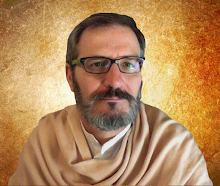The word Satsang means company
of truth. This is the inner experience of sharing orally or in
writing. Satsang is one of the three feet of the Agya with the
Meditation and the Service. The Agya is all what makes the. practice
of the yoga-original.
What the
Satsang is
Summary:
The word Satsang consists of two syllables, sat: perfection, Truth and sang : company, which gives: "Company of the Truth." Satsang is part of the practice of the path, with the Meditation without thoughts and the Meditation in action or Duty. The practice of the path, composed of these three elements is the Agya.
The word Satsang consists of two syllables, sat: perfection, Truth and sang : company, which gives: "Company of the Truth." Satsang is part of the practice of the path, with the Meditation without thoughts and the Meditation in action or Duty. The practice of the path, composed of these three elements is the Agya.
The Satsang is given orally, ideally or in writing if it is impossible to hear it. The orally given Satsang is a kind of monologue, of sermon as we said at the time of the Christ.
According to the teaching only the Guide and the premie (disciples
of the fourth degree of practice) can give Satsang. The person who
gives Satsang meditates on the “Holy-Name” a few moments before
speaking. When it feels this “inner-smile” in the top of the
chest, it opens the eyes and improvises a “sermon”.
We used to say that the
important thing, in Satsang, is not the saying concepts but the
contents of the words, the feeling. It has to be noticed that only
those which know and frequent the Truth regularly are able to give
Satsang. This word is not deposited by the Path and all the movements
make use of it to name the speeches which they hold.
The Satsang of the guide,
sri Hans yoganand ji (alias josé) and who is published on the blog
Paroles de vérité was given orally within the ashram nandi-àlaya,
was recorded and retranscribed. The Satsang of the guide is at the
same time the media of his teaching. What makes the path is its
teaching.
The word Satsang breaks up into two syllables,
sat: perfection, Truth and sang: company,
what gives: “company of the Truth”.
Satsang is part of the practice of the path,
with the Meditation and the Duty.
sat: perfection, Truth and sang: company,
what gives: “company of the Truth”.
Satsang is part of the practice of the path,
with the Meditation and the Duty.
Agya: Duty, Satsang,Méditation
Each one of these three parts is essential if you want to live this spirituality with some satisfactions. The Satsang is to speak, or write starting from its experiment and under the inspiration of the inner-Peace. The Satsang is also to listen and read the narratives of a yoga-originel practitioner arriving at the stage of premie or “god's lover” and of the guide. The Satsang of the guide conveys also his teaching.
[Bhaktimàrga 3-1-10]
You know what you hope to find
in the deep Meditation: a transcendental experiment of the ineffable
one. This is the more attractive side of the path, the strongest
promise even if often the experiment is limited to a centring what is
already much when you realise what this centring brings to you in
your daily life.
As regards the Meditation in
action, or Duty, you know that you have to practise it as often and
as long as possible throughout the day, especially at the degree of
practice of Chela, or disciple, in order to keep your emotions under
contro. The purpose of the Realization, which is one of the goals of
the path, in any case for a disciple and a premie, is not so much to
plunge in the nirvikalpa-samadhi, or ecstasy, by the sitted
meditation as to make with the deep spirituality, the Conscience, a
daily reality.
[Bhaktimàrga 2-3-23]
As regards the Satsang it is in the same way an inescapable date in the life of a practitioner. The benefit to receive Satsang is to inspire. In the Duty you have the concept to make all the daily tasks by keeping the spirit centered and by seeking the excellence, without waiting of reward, without being attached to the result, some then speak about nonact.
[Bhaktimàrga
2-4-15]
The given Satsang is also part of the Duty, for a premie: it is a question of sharing the experiment, it is necessary to say that the path exists and what it brings in his/her life, to share without seeking to convince. More than the verbal, conceptual contents of Satsang, the feeling of Truth must touch at the listener or the reader a cord which did not vibrate any more and requires to vibrate again.
The Christ told to his
disciples, in connection with that: ''And he said to them, When
the light comes in, do people put it under a vessel, or under the
bed, and not on its table? There is nothing covered which will not be
seen openly, and nothing has been made secret which will not come to
light. If any man has ears, let him give ear '' .[Mark 4:21,22,23]
Satsang is never a dialogue:
when a premie, the guide gives Satsang
one listens to it without stopping him from the beginning to the end.
If one wants to dialogue, to ask questions it is possible
but one will do it before or afterwards.
when a premie, the guide gives Satsang
one listens to it without stopping him from the beginning to the end.
If one wants to dialogue, to ask questions it is possible
but one will do it before or afterwards.




